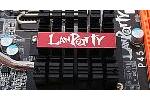|
DFI LANParty JR P45 T2RS Tested
|
 The DFI LANParty JR P45 T2RS tries to bridge the gap between enthusiast and the average Joe Martin user and gets stuck at what it does best - offering the end user a chance to endless abuse the CPU-northbridge and memory, while entirely forgetting that it needs a variety of features to compete more competently in the P45 arena. While DFI fanboys will no doubt harp on until the end of time about how it's all to do with overclocking, for the rest of us, once we've left the BIOS all we're left with is a feeling of mediocrity, where the JR P45 doesn't have quite the level of thoughtfulness other DFI products have been given. The unbalanced bundle, the rubbish northbridge screws, the clear CMOS jumper on the rear I/O, the BIOS's craptacular CPU fan control, poor BIOS flash options, no Firewire, no eSATA (yet there could easily be) and hit-and-miss sound quality: all this speaks of a distinct lack of TLC. It all comes down to asking whether microATX has its own specific customer, therefore it cannot readily be compared to full ATX boards - like how you either buy a non-modular or modular PSU - because the customer has a specific need. In this respect the DFI has its own market and for those wanting an SFF case with a lot of gaming potential, the DFI offers it. A pair of HD 4850s don't cost much and should give some great 1080p gaming, even if this isn't the fastest board to do so. Comparing to full ATX boards on performance alone, the DFI LANParty JR P45 T2RS is pretty good, despite the odd hiccup, and it's a good board with great stability. The ABS system is made for very simple, yet fan-frolicking-tastic overclocks by changing preset profiles. The only downside is that you need an E8500, although we expect E8600/8400/8200s will work as well. Those with the super-popular Q6600 might like some presets for Kentsfields too, though. Essentially unless you're specifically after a DFI fuelled microATX motherboard with CrossFire support, an enlightening BIOS experience and a BEAST of an overclocker, it is being left behind by the features the competition are pushing for the same money. As one of the only powerful microATX boards out there, it will certainly suffice for the task: it's good at what it does, but don't buy it over more complete full ATX boards unless you have to.
The DFI LANParty JR P45 T2RS tries to bridge the gap between enthusiast and the average Joe Martin user and gets stuck at what it does best - offering the end user a chance to endless abuse the CPU-northbridge and memory, while entirely forgetting that it needs a variety of features to compete more competently in the P45 arena. While DFI fanboys will no doubt harp on until the end of time about how it's all to do with overclocking, for the rest of us, once we've left the BIOS all we're left with is a feeling of mediocrity, where the JR P45 doesn't have quite the level of thoughtfulness other DFI products have been given. The unbalanced bundle, the rubbish northbridge screws, the clear CMOS jumper on the rear I/O, the BIOS's craptacular CPU fan control, poor BIOS flash options, no Firewire, no eSATA (yet there could easily be) and hit-and-miss sound quality: all this speaks of a distinct lack of TLC. It all comes down to asking whether microATX has its own specific customer, therefore it cannot readily be compared to full ATX boards - like how you either buy a non-modular or modular PSU - because the customer has a specific need. In this respect the DFI has its own market and for those wanting an SFF case with a lot of gaming potential, the DFI offers it. A pair of HD 4850s don't cost much and should give some great 1080p gaming, even if this isn't the fastest board to do so. Comparing to full ATX boards on performance alone, the DFI LANParty JR P45 T2RS is pretty good, despite the odd hiccup, and it's a good board with great stability. The ABS system is made for very simple, yet fan-frolicking-tastic overclocks by changing preset profiles. The only downside is that you need an E8500, although we expect E8600/8400/8200s will work as well. Those with the super-popular Q6600 might like some presets for Kentsfields too, though. Essentially unless you're specifically after a DFI fuelled microATX motherboard with CrossFire support, an enlightening BIOS experience and a BEAST of an overclocker, it is being left behind by the features the competition are pushing for the same money. As one of the only powerful microATX boards out there, it will certainly suffice for the task: it's good at what it does, but don't buy it over more complete full ATX boards unless you have to.
|
|
Quelle: bit-tech.net (E)
|



 The DFI LANParty JR P45 T2RS tries to bridge the gap between enthusiast and the average Joe Martin user and gets stuck at what it does best - offering the end user a chance to endless abuse the CPU-northbridge and memory, while entirely forgetting that it needs a variety of features to compete more competently in the P45 arena. While DFI fanboys will no doubt harp on until the end of time about how it's all to do with overclocking, for the rest of us, once we've left the BIOS all we're left with is a feeling of mediocrity, where the JR P45 doesn't have quite the level of thoughtfulness other DFI products have been given. The unbalanced bundle, the rubbish northbridge screws, the clear CMOS jumper on the rear I/O, the BIOS's craptacular CPU fan control, poor BIOS flash options, no Firewire, no eSATA (yet there could easily be) and hit-and-miss sound quality: all this speaks of a distinct lack of TLC. It all comes down to asking whether microATX has its own specific customer, therefore it cannot readily be compared to full ATX boards - like how you either buy a non-modular or modular PSU - because the customer has a specific need. In this respect the DFI has its own market and for those wanting an SFF case with a lot of gaming potential, the DFI offers it. A pair of HD 4850s don't cost much and should give some great 1080p gaming, even if this isn't the fastest board to do so. Comparing to full ATX boards on performance alone, the DFI LANParty JR P45 T2RS is pretty good, despite the odd hiccup, and it's a good board with great stability. The ABS system is made for very simple, yet fan-frolicking-tastic overclocks by changing preset profiles. The only downside is that you need an E8500, although we expect E8600/8400/8200s will work as well. Those with the super-popular Q6600 might like some presets for Kentsfields too, though. Essentially unless you're specifically after a DFI fuelled microATX motherboard with CrossFire support, an enlightening BIOS experience and a BEAST of an overclocker, it is being left behind by the features the competition are pushing for the same money. As one of the only powerful microATX boards out there, it will certainly suffice for the task: it's good at what it does, but don't buy it over more complete full ATX boards unless you have to.
The DFI LANParty JR P45 T2RS tries to bridge the gap between enthusiast and the average Joe Martin user and gets stuck at what it does best - offering the end user a chance to endless abuse the CPU-northbridge and memory, while entirely forgetting that it needs a variety of features to compete more competently in the P45 arena. While DFI fanboys will no doubt harp on until the end of time about how it's all to do with overclocking, for the rest of us, once we've left the BIOS all we're left with is a feeling of mediocrity, where the JR P45 doesn't have quite the level of thoughtfulness other DFI products have been given. The unbalanced bundle, the rubbish northbridge screws, the clear CMOS jumper on the rear I/O, the BIOS's craptacular CPU fan control, poor BIOS flash options, no Firewire, no eSATA (yet there could easily be) and hit-and-miss sound quality: all this speaks of a distinct lack of TLC. It all comes down to asking whether microATX has its own specific customer, therefore it cannot readily be compared to full ATX boards - like how you either buy a non-modular or modular PSU - because the customer has a specific need. In this respect the DFI has its own market and for those wanting an SFF case with a lot of gaming potential, the DFI offers it. A pair of HD 4850s don't cost much and should give some great 1080p gaming, even if this isn't the fastest board to do so. Comparing to full ATX boards on performance alone, the DFI LANParty JR P45 T2RS is pretty good, despite the odd hiccup, and it's a good board with great stability. The ABS system is made for very simple, yet fan-frolicking-tastic overclocks by changing preset profiles. The only downside is that you need an E8500, although we expect E8600/8400/8200s will work as well. Those with the super-popular Q6600 might like some presets for Kentsfields too, though. Essentially unless you're specifically after a DFI fuelled microATX motherboard with CrossFire support, an enlightening BIOS experience and a BEAST of an overclocker, it is being left behind by the features the competition are pushing for the same money. As one of the only powerful microATX boards out there, it will certainly suffice for the task: it's good at what it does, but don't buy it over more complete full ATX boards unless you have to.